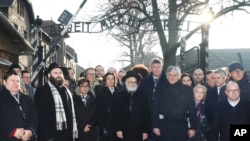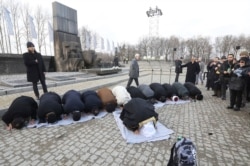For some 7,000 starved and sick prisoners in the world’s most notorious mass-murder site, January 27, 1945 was a life-changing day.
It was the day Russian soldiers liberated the remaining prisoners of Auschwitz, left behind when ca. 56,000 healthier inmates were sent on aptly named “death marches” west toward German territory.
Among those rescued – ironically, saved because they were too ill to survive a march – was Primo Levi, a writer later known for his stirring reflections on what it means to be human. Also waiting there was Otto Frank, the father of diarist Anne Frank, and the person who ushered her diary of life in hiding in Amsterdam into publication. The book is now one of the best-known memoirs in the world.
Today, if it weren’t for the railroad tracks, the ruins of barracks, and the stern, overbearing presence of the high barbed wire fences, it might be possible to forget the misery and mass executions that took place at the Auschwitz. The Auschwitz Memorial is located some 70 kilometers west of Krakow, Poland.
While the foundations and boundaries of the camp that survived the war have been preserved, in the spaces that have been left empty for 75 years a warm-weather visitor can find wildflowers in bloom and hear a chorus of birdsong. At a pond where human ashes were dumped, dragonflies swoop and flutter and unseen frogs croak. It is disturbingly easy to forget why the fields have been left empty.
Yet, the survivors do not forget.
Day of remembrance
This January 27, the Auschwitz-Birkenau Memorial and Museum and many other institutions around the world are holding ceremonies marking the day that has become known as International Holocaust Remembrance Day, with a dwindling group of survivors left to tell the story and a plethora of questions about how to educate new generations about the endgame of unchecked hate.
The Conference on Jewish Material Claims Against Germany has undertaken surveys of 1,100 to 2,000 respondents in the past few years in the United States, Canada, and Austria in the past two years. It has found that a substantial number of people are unclear on the facts of the Holocaust: how many people died, who was responsible, and where it occurred. Lack of knowledge was greatest among millennials, a generation that may not have had much exposure to family members or others with first-hand accounts of what happened.
In the United States in 2018, 22% of millennials said they had not heard, or were unsure if they had heard, of the Holocaust. Forty-nine percent could not name a concentration camp, not even Auschwitz. And in the U.S., Canada and Austria, fewer than half were clear on how many Jews had died in the Holocaust. (Six million Jews – two-thirds of Europe’s Jewish population -- and an estimated 5 million others, including Poles, Roma and dissidents.)
In the U.K., a 2019 study of more than 2,000 people found that 5% of U.K. adults do not believe the Holocaust took place and one in 12 believe its scale has been exaggerated. In a survey by Opinion Matters for the Holocaust Memorial Day Trust, 45% said they did not know how many people were killed in the Holocaust.
75th anniversary is significant
While several hundred thousand Holocaust survivors are still alive today, the 75th anniversary is probably the last big one where there will be a significant number of survivors present.
That presents educators with some challenges. Keeping the message alive, they agree, is important.
Diane Saltzman, director of constituency engagement at the United States Holocaust Memorial Museum, said in a recent email, “It’s the lessons the survivors have to teach us – about the dangers of unchecked hatred and anti-Semitism, our susceptibility to ignore the plight of others -- that are urgent and timeless."
Anti-Semitism endures long after the lessons of the Holocaust were made clear. And recent years have seen an uptick in overt anti-Jewish behavior.
The Anti-Defamation League, which tracks anti-Semitic attacks, reported that in 2017 the United States saw a spike of 57% more incidents motivated by anti-Jewish bias than the year before.
Holocaust educators say the cultural climate is becoming more open to hate speech.
Jack Kliger, president and CEO of New York City’s Museum of Jewish Heritage: A Living Memorial to the Holocaust, said the shame that once surrounded anti-Semitism is going away. The thing that really disturbed him about the 2017 neo-Nazi march in Charlottesville, Virginia, wasn’t that folks were out exercising their right to free speech.
“It was the fact that they didn’t feel they needed to wear masks,” he said. “Today, it almost feels as if we’re living in the 1930s.
Ken Jacobson, the Anti-Defamation League’s deputy national director, expressed something similar. When testifying before Congress a few years ago, he said, a congressman asked him what keeps him up at night.
"My answer is related to the loss of shame about anti-Semitism,” he said. “Those inhibitions are disappearing. ... Today, people are feeling freer to act out on their prejudice.”
Open to education
That trend makes it ever more important, Holocaust educators say, to teach people what led up to the Holocaust and how it could happen again. And Claims Conference surveys show most people are open to more education – 93% of Americans surveyed said Holocaust education should be taught in schools. Three-quarters of Austrians surveyed agreed that more education is needed.
Pawel Sawicki is a press officer and educator for the Auschwitz Memorial and Museum and the organization’s main coordinator for a traveling exhibition called “Auschwitz: Not Long Ago. Not Far Away.”
The exhibition, created by Spain's Musealia in partnership with the Auschwitz Memorial and featuring displays and artifacts mainly from Memorial’s collections, aims to recreate part of the experience of visiting the site for those who cannot travel to see it. Its stay at the Museum of Jewish Heritage in New York has just been extended to August 2020.
The Holocaust happened, Sawicki said in a recent interview, “because they believed in an ideology that dehumanized other people.”
Jack Kliger said the exhibit is an important part of the effort to teach the lessons of the Holocaust to younger generations. Twenty-five thousand students have visited the exhibit since it opened in New York in May 2019. Kliger said they hope to host another 25,000 students before the exhibit closes in August.
“How do you fight ignorance and fear?” Kliger asked rhetorically. “The answer is to make people informed and give them an understanding of what happened before and what could happen again.”
Efforts at education continue in other venues, as well. Sawicki said the Auschwitz Memorial and Museum is reaching out via social media to communicate with interested parties and share its message.
When Baraboo High School in the U.S. state of Wisconsin made the news with a photo of male students making the Nazi salute, Auschwitz made contact and sent them a panel exhibition, to teach the students why their gesture had offended so many people but also give them enough facts to understand the complicated history of the human suffering at Auschwitz.
Twitter campaign
As the person in charge of the Auschwitz Twitter feed – as it, and Facebook, provide the memorial a way to have two-way interchange with interested parties – Sawicki is also heading a drive to get more followers. As of today, the organization's Twitter feed has more than one million followers."
Beyond words, however, Sawicki sees another way to help young people understand the horror and history of the Holocaust – art. The memorial is currently planning a permanent exhibition of art created in the camps.
“Art is a universal language,” he said. “If you participate in a meeting between a young person and a survivor, there are rarely questions about fact. They very quickly . . . begin to ask about emotions. What did it feel like to be hungry?”
All these actions work toward the goal, Holocaust educators say, of teaching people to stand up in the face of hatred in hopes of preventing future tragedy.
Saltzman, of the U.S. Holocaust Memorial Museum, said, “History can help us understand the present by examining the motivations, pressures, and decisions people made in extreme circumstances. Human nature doesn’t change. Therefore we all have a responsibility to act in the face of hatred, anti-Semitism, and indifference.”
And Kliger of the Museum of Jewish Heritage, agreed. “We always talk about the Holocaust in terms of victims, perpetrators, and bystanders. We’re starting to say you need to be an ‘upstander.’ You can’t just be a non-active observer anymore," he said.













